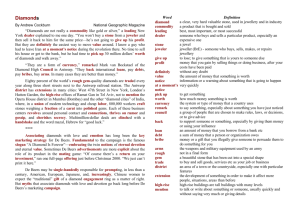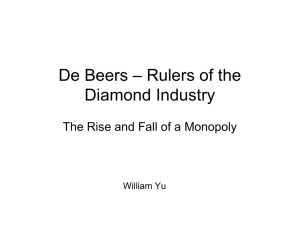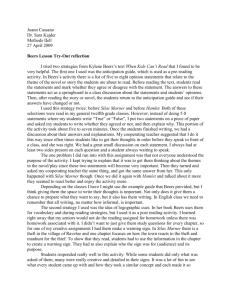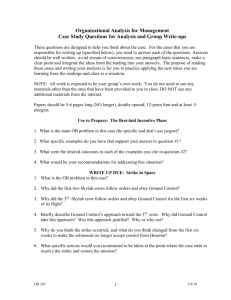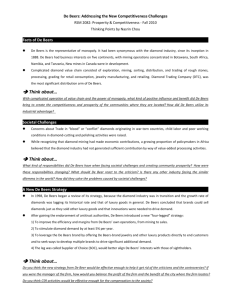De Beers Presentation - FINAL
advertisement
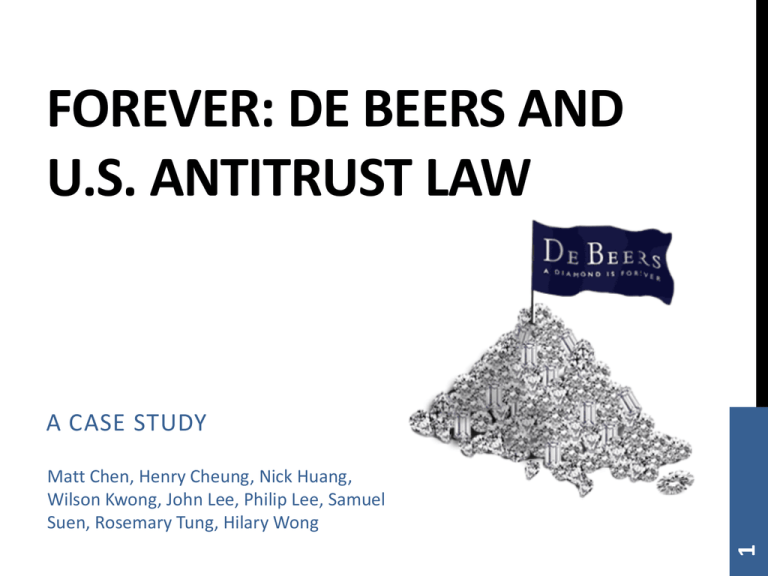
FOREVER: DE BEERS AND U.S. ANTITRUST LAW A CASE STUDY 1 Matt Chen, Henry Cheung, Nick Huang, Wilson Kwong, John Lee, Philip Lee, Samuel Suen, Rosemary Tung, Hilary Wong INTRODUCTION • Points to keep in mind: 2 • How can we apply the De Beers business model to other real world businesses? • What are the conditions for the De Beers business model to work? OVERVIEW Introduction Background Analysis Implications 3 Conclusion INTRODUCTION • De Beers Group: 4 • The world’s leading diamond company and international cartel • Expertise in Exploration, Mining and Sale of diamonds • Consists of several companies 5 COMPANY ORGANIZATION BACKGROUND • Discovery of diamonds in South Africa in mid-1800s • Large influx of prospectors and miners 6 • De Beers was founded by Cecil Rhodes in 1888 BACKGROUND • Formed “Diamond Syndicate” – a coalition consisting of producer (De Beers) with merchants • A new syndicate formed by Ernest Oppenheimer in 1927 to strengthen link between producers and merchants 7 • Reached out to other major producers of rough diamonds to sell to De Beers BACKGROUND • Monopoly: • Specific person or enterprise is the only supplier of a particular commodity • Lack of economic competition to produce the good or service and a lack of viable substitute goods • Cartel: 8 • Explicit agreements among producers to set output and price • Formal organization where there is a small number of sellers and usually involve homogeneous products ANALYSIS – THE PRODUCT Diamonds Gold Similarities Obtained from mines Highly priced Perceived as rare by the public Aesthetic value Obtained from mines Highly priced Perceived as rare by the public Aesthetic value Differences Actually not that rare Quality varies tremendously Physically small and light Volume sufficient for use as currency Relatively low liquidity Two diamond grades: gem and industrial Actually rare Relatively uniform quality Varying sizes, but heavy Volume not sufficient for use as currency Relatively high liquidity 9 • Illusion of Scarcity is important: • Without it, diamonds are almost useless, worthless • No market would exist (maybe only industrial market) • Things that are difficult to obtain are typically more valuable • When things become less available, choice become limited - makes people want the product significantly more than they would have otherwise. • More motivated by the thought of losing something than by the thought of gaining something of equal value • Threat of potential loss – miss out on opportunity 10 ANALYSIS – THE PRODUCT ANALYSIS – THE PRODUCT • Controlled Supply of Diamonds • Via the formation and actions of cartel • Effective Marketing – “A diamond is forever.” 11 • Discourages re-sale by consumers • Effectively limits supply available on market ANALYSIS – THE MONOPOLY De Beers Microsoft Similarities Have control over companies along the supply chain Persecuted by US authorities for violation of anti-trust laws Monopolized one key aspect of the industry – steam-powered pump Have control over companies along the supply chain Persecuted by US authorities for violation of antitrust laws Monopolized one key aspect of the industry – the Operating System software Differences Operates outside of US (Extraterritoriality) Does not sell directly to the US Maintained monopoly by funneling diamonds through “one channel” Operates in the US Sells directly to the US Maintained monopoly through network effect and economies of scale 12 ANALYSIS – THE MONOPOLY • South Africa was main source of diamonds • Diamonds: major industry for Africa • De Beers monopolized the steam-powered pump (needed for diamond production) • Cecil Rhodes rented out steam-powered pump to mines • Bought out all other claim holders and mines • De Beers became the sole producer of diamonds 13 • Control supply by buying back and stockpiling excess diamonds ANALYSIS – THE CARTEL De Beers Similarities Controlled supplies, distribution, and price Sell relatively expensive products Structural commitment amongst companies Enforcement of agreements and terms Effective punishment mechanisms for cheaters Controlled supplies, distribution, and price Sell relatively expensive products Structural commitment amongst gangs Enforcement of agreements and terms Effective punishment mechanisms for cheaters Differences Products themselves are legal Punish cheating by manipulating market/supply Have the support of local authorities Operates on an international scale Products themselves are illegal Punish cheating via the use of violence Does not have the support of authorities Operates on a local/domestic scale 14 Drug Cartel ANALYSIS – THE CARTEL 15 • Collusion amongst all members along the “diamond pipeline” • Facilitated the ongoing arrangement between producer and merchants to keep supplies low and prices high • Ensured uniform prices across the industry and straight down the retail level • Ensured stable prices, guaranteed purchases, and buffer against competition • The tension between the collective and individual interests of firms – Prisoner’s Dilemma ANALYSIS – THE CARTEL • A combination of monitoring, rewards, and punishments is needed to prevent cheating by members • Effective punishment for cheaters: • Deny sales to sightholders • Flood the market • Deter defection: 16 • Pay the members to not defect • Loan money and acquire diamond stockpiles ANALYSIS – THE CHANGES 17 • No longer the sole producer of diamonds – Russia, Angola, Canada, Australia • Ultimately, members (such as the Russians and Angolans) defected • Flow of illicit diamonds (Blood Diamonds) • The sales of diamonds from US is increasing • Mounting pressure from regulators concerning monopolistic business practices ANALYSIS – THE CHANGES 18 • Increased investments in company from US investors • Costliness of stockpiling and buy backs is becoming more apparent • Increasing demands from investors for more efficient use of company resources • De Beers: Shift towards advertising and branding itself, rather than for the diamond industry • Through power of brand and marketing, introduces a third grade of diamonds: the De Beers (luxury) grade WAITING. 19 IMPLICATIONS? You are probably IMPLICATIONS • Implication 1: • Valuation and demand for a product can be affected by the consumer’s perception of product scarcity. • Additional Points: 20 • The consumer’s perception, can in turn, be manipulated. • In De Beer’s case, through control of supply and marketing • Other examples: time-limited purchases/offers – “for a limited time only, hurry while stocks last” IMPLICATIONS • Implication 2: • Only need to control one key aspect of the industry to monopolize the entire industry • Additional Points: 21 • For De Beers: monopolized the steam-powered pump (needed for diamond production), rather than production itself • Other examples: Microsoft, dominated the entire PC industry by monopolizing the operating system software IMPLICATIONS • Implication 3: • Control of distribution allows for the detection of cheaters downstream along the product pipeline • Additional Points: 22 • For De Beers: cheating will only take place during distribution, since it already controls supply • Other examples: cheating during distribution of industrial/medical gases – offering ancillary services at lower prices (ie. offering lower transport charges or rental charges of gas cylinders) IMPLICATIONS 23 • Implication 4: • The success of a cartel is product and location dependent • Additional Points: • For De Beers: Diamonds are small, lightweight, easy to store, and portable - does not require a lot of effort to move or space and therefore easy to stockpile (unlike gold, oil); not perishable (unlike rice) • For De Beers: operates in a relatively poor, developing region of the world with little regulations – region is economically dependent on industry (like OPEC, region is dependent on oil industry) IMPLICATIONS • Implication 4: • The success of a cartel is product and location dependent • Additional Points: 24 • For De Beers: product allows for effective punishment to cheaters, while minimize harm to self • Example: flood market with industrial grade diamonds, without harming market for gem grade (unlike OPEC, major producer have to hurt itself by reducing its own output) IMPLICATIONS • Implication 5: • Being the major (if not the only) player in an industry, it is in the company’s best interests to exert control and act on the industry’s behalf. • Additional Points: 25 • For De Beers: was one time the major (only) producer of diamonds • As major/dominant player, you have the most to lose – The Rational Pigs • Formation of a cartel can fulfill this objective IMPLICATIONS • Implication 5: • Being the major (if not the only) player in an industry, it is in the company’s best interests to exert control and act on the industry’s behalf. • Additional Points: 26 • Other examples: Rare Earth industry – China is major producer – tightly regulates exports • Prediction: if you are no longer the only major player, you should act on your own behalf IMPLICATIONS • Implication 5: • Being the major (if not the only) player in an industry, it is in the company’s best interests to exert control and act on the industry’s behalf. • Additional Points: 27 • Fact: De Beers is no longer a monopoly • Other examples: AT&T – at one point, the only supplier of telephones; when third-party equipment became available, no longer only player – divested and monopoly no longer EBITDA FOR DE BEERS Year 28 $ USD Earnings has steadily increased since De Beers abandoned its monopoly in 2004, reaching an all-time high in 2008. In 2009, earnings declined due to the worldwide economic crisis. RECALL • Points to keep in mind: 29 • How can we apply the De Beers business model to other real world businesses? • What are the conditions for the business model to work? CONCLUSION • Valuation and demand for a product can be affected by the consumer’s perception of product scarcity. • Only need to control one key aspect of the industry to monopolize the entire industry 30 • Control of distribution allows for the detection of cheaters downstream along the product pipeline CONCLUSION • The success of a cartel is product and location dependent 31 • Being the major (if not the only) player in an industry, it is in the company’s best interests to exert control and act on the industry’s behalf CONCLUSION • Like most things in life, nothing lasts forever - the only constant is change • Business models (no matter how successful) are no exception and must be adapted for changes – only serves as a reference for past success/failure 32 • A Diamond is NOT forever… will eventually turn to graphite THE END. 33 THANKS FOR LISTENING!
